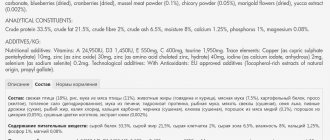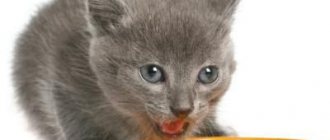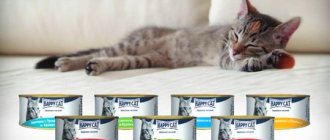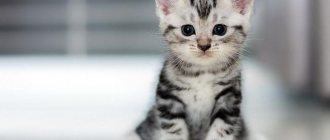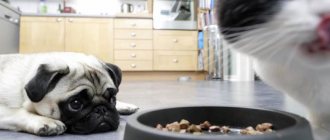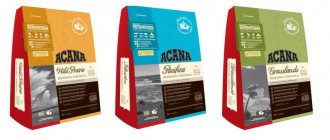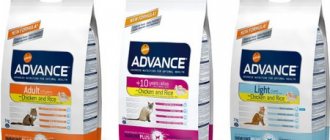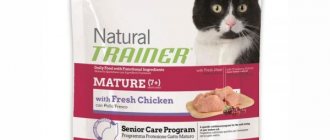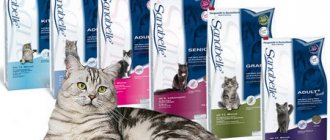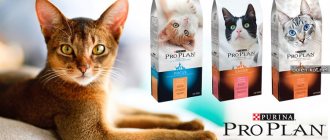Home » Useful Information
Disputes over the possible harm of dry food still continue to this day. Even among veterinarians there is no consensus. In fact, it is impossible to unequivocally answer the question of whether dry food is dangerous, since much depends on the composition of the diet and its class.
- 2 Which dry foods are most dangerous?
- 3 What diseases can occur when eating dry food?
- 4 How to minimize the harm of dry food
- 5 Video: a specialist talks about whether dry food is harmful
- 6 Opinion of experts and animal owners
Benefit or harm?
This method of feeding is in great demand among animal owners. The advantages of feed are its long-term storage and balance. You can add food for a day and not be afraid that the animal will be hungry in the absence of the owner. Cats eat food with pleasure, and this is not surprising.
But is dry cat food harmful? Many well-known brands of products contain components that stimulate appetite and improve taste. Thanks to modern technology, low-quality feed appears attractive to animals. Eating such a product becomes addictive, and the cat begins to refuse other food.
Many foods are oversaturated with carbohydrates, which are harmful to animals. Such a diet can negatively affect the condition of the stomach and kidneys. 24/7 access to food causes obesity in cats, which is unnatural for animals. It is better to use two meals a day.
Dry food is the main cause of urolithiasis in cats. The reason is insufficient saturation of the body with fluid. Also, high carbohydrate content in food increases sugar levels and can lead to diabetes. To avoid this, you should choose meat-based food.
Mr. Cat recommends: the pros and cons of different types of nutrition
There are two types of food for feeding pets: natural and industrial. Among breeders and veterinarians there are adherents of each species, and it is difficult to say which diet is healthier and more correct. Of course, we are talking about good super premium or holistic food. If the funds allow you to feed your cat only economy or not very high-quality premium, then it is better to stick to natural food.
Let's consider the advantages and disadvantages and everyone will choose the most acceptable diet for their pet.
| Advantages | Flaws |
| Natural | |
|
|
| Industrial | |
|
|
Each owner knows the characteristics of his pet, food preferences, and attitude to water. The most common problem with dry-fed animals is insufficient fluid intake. These cats are usually fed wet foods of the same brand.
Recommendations for using dry food
When using this food you need to follow some rules. First of all, you cannot mix ready-made food with natural food, since the imbalance of nutrients is disrupted. If a problem occurs, it will be difficult to understand the real reason. Also, do not change the brand of food often. This leads to poor absorption of substances and causes disturbances in the body. If you need to change food, you should do this gradually over 1-2 weeks, adding a new product and increasing its quantity.
Cats by nature drink little water, and dry food is recommended to be washed down with plenty of liquid. Therefore, for better absorption, you need to ensure that there is always water next to your food bowl. Veterinarians recommend diluting the diet with wet food. When feeding kittens, you should pay attention to the packaging labeling, which should indicate the age at which the product can be consumed.
How to minimize the harm of dry food
To prevent the development of diseases, it is recommended to purchase holistic or high-quality super premium food. If the animal has any pathologies, it is advisable to consult a veterinarian to choose the most suitable product. Hygiene procedures will help prevent the formation of tartar. If your cat swallows the pellets whole, it is advisable to purchase a special bowl with large cones so that the animal is forced to eat slowly. In some cases, it is wise to combine dry food with wet food.
Which food is better to choose?
When choosing a diet for a cat, you should focus on the composition, which will make it clear whether feeding your cat dry food of this brand is harmful. The highest quality food is made from animal meat and ocean fish. They contain all the necessary nutrients and do not contain harmful components.
A high-quality product will not cause allergies and other unpleasant consequences, but, on the contrary, will help prevent them. Often, special dry food is used to treat diseases. Many are put off by the price of such “cat joy”, but considering the cost of fresh food, it is quite justified. And if you calculate the effort and time that will be required to prepare a balanced menu for your pet, then dry food will be a priority.
What ingredients should not be in dry food?
The presence of grains is not welcome. The most dangerous are wheat, corn and soybeans. In some low-quality foods, they are divided into several positions: flour, gluten, extracts, etc. In super-premium products you can find barley and oats, but they are also usually used as cheap fillers, so grain-free diets are preferable.
The composition should not contain general names: “animal fat”, “protein plant extract”, “poultry”, “cereals”, “by-products”, etc. The lack of specifics is most often associated with the use of low-quality components. For example, the name “offal” can equally likely hide livers and hearts, as well as beaks and scallops. Vague formulations allow the manufacturer to regularly change the recipe depending on the market situation. For example, one batch of feed may contain only corn as grains, while another may contain a mixture of wheat and corn. This is most dangerous for animals prone to allergies, since in case of intolerance it will be impossible to identify the irritant.
Most often, manufacturers claim that they do not use dyes at all, but it is difficult to achieve such shades without additives
The use of dyes is not recommended. They do not contain useful substances, but they can harm your pet. Some dyes can irritate the delicate mucous membranes of the gastrointestinal tract and urinary tract. This can provoke inflammation and the development of diseases.
Preservatives should always be present in dry food, as they prevent spoilage, but the type of ingredient is important. It is preferable to preserve it with a mixture of vitamins E and C, as well as rosemary. If the generic label "preservatives" is listed on the package, there is a good chance it contains sodium (salt) and dangerous antioxidants. An excess of minerals can trigger the development of urolithiasis.
The presence of vitamins, minerals and amino acids in their pure form in dry food is undesirable. The presence of several positions is allowed, but not common names, as well as taurine and methionine. The latter amino acids are found in meat, so their addition indicates an insufficient amount of animal products in the composition. Minerals and vitamins should be included in vegetable, fruit and herbal supplements.
Is Kitekat and Whiskas dry cat food harmful?
Since cats are carnivores, their digestive system is not adapted to food of plant origin. Meat products completely lack carbohydrates and other vitamins that animals need. But wild cats get the necessary substances from the stomachs of the herbivores that they feed on. At the same time, they arrive to predators already in a processed form, which allows them to absorb some of the carbohydrates. The resulting dietary fiber helps cleanse the intestines. But apartment residents can only rely on a person. The owner takes responsibility and must know whether the dry cat food he feeds his pet is harmful.
“Kitekat” and “Whiskas” are unbalanced or poorly balanced feeds and do not contain all the necessary nutrients. Their use often leads to various disorders in the cat’s body. These feeds belong to the economy class and contain meat waste: skin, intestines, heads, as well as offal with low nutritional value. They contain too much corn, wheat and rice flour. In this case, you can answer the question positively: is dry food harmful for cats and kittens? Daily consumption of such food leads to gastrointestinal disorders, kidney and liver diseases, as well as hair loss. This product negatively affects the growth and development of kittens. Carbohydrates are not digested and disrupt intestinal function.
Which dry foods are most dangerous?
The greatest danger is posed by low-quality, spoiled and incorrectly selected dry food. It is strictly forbidden to offer medicinal products to an animal without a veterinarian's prescription. The composition of specialized foods is designed to maintain a satisfactory state of health in cases where the pet has special needs. For example, in case of liver diseases, the proportion of fats in the diet is reduced. In a healthy cat, deficiency can lead to weakness and skin problems, as well as impaired immunity. Medicinal food is given strictly in courses or for life, depending on the type of pathology and the instructions of the veterinarian.
Most manufacturers of multi-colored kibble claim that there are no dyes in their food, but it is almost impossible to achieve such bright colors without additives, so it is better to avoid such products
It is advisable to exclude any economy or premium class products from your pet’s menu. The composition of such feeds is predominantly represented by cereals, the proportion of ingredients of animal origin is minimal. To save money, producers prefer to add not pure muscle meat or whole carcasses, but a mixture of offal and waste. Theoretically, such components contain useful substances, but the cat’s body fails to absorb them. Occasionally, manufacturers of super premium food do the same, so before purchasing you need to pay attention to the composition. The preferred ingredients are various types of meat and fish, as well as whole carcasses without internal organs. The presence of generic names in the composition is not recommended. For example, a “mixture of meat and offal” could actually be anything, including bones with remnants of flesh. The presence of a small amount of chicken heads, cartilage, liver, hearts, lungs and some other organs is allowed, but these ingredients should not be placed in the first place.
The granules of high-quality dry food should be uniform and have a brown tint; the darker the color, the higher the proportion of meat ingredients in the composition
It is recommended to avoid grains in the composition. At best, they will do neither good nor harm. Cats need proteins and fats more than carbohydrates. They have difficulty absorbing nutrients from grains. Cereals are not very nutritious for pets, so often the animal remains hungry even after the recommended portion. Due to overeating and excess plant ingredients on the menu, a cat may develop diabetes or obesity. The only significant benefit of grains is the presence of fiber in the chemical composition, but the animal can obtain fiber from other, healthier ingredients. For example, legumes, vegetables or fruits. Sometimes manufacturers of budget grain-free food try to replace grains with peas and lentils. This is also not welcome due to the poor digestibility of plant proteins. The presence of legumes is acceptable, but they should not be in the first 3–5 positions.
The presence of flavoring additives in economy-class food is most often not mentioned in the composition, however, many animal owners complain that their pets behave inappropriately at the sight of granules and refuse other food
The greatest dangers for cats are sugar, dyes, as well as some preservatives and flavoring additives. They do not carry any nutritional value, but can irritate mucous membranes, cause inflammation or impair the functioning of internal organs. If the presence of sugars and dyes is clearly a disadvantage, then with preservatives and flavoring additives the situation is not so categorical. Antioxidants are needed in any case to prevent oils from going rancid and the development of bacterial colonies. Their absence is fraught with poisoning or infection of the animal. Many companies preserve feed using tocopherols, ascorbic acid, rosemary and other natural ingredients. This is a more expensive but safer method. You should be wary if the composition contains the general name “antioxidants” or “preservatives”: most likely, the manufacturer is hiding something. The most common components used in budget foods are hydroxyanisole butylate and hydroxytoluene butylate. They negatively affect the kidneys, liver and reproductive system, and also increase the risk of developing cancer.
Flavoring additives help make food more attractive to picky cats. Digests are considered relatively safe - broths that are obtained from animal tissues and sprayed onto granules. Sometimes chicken or turkey liver is used for these purposes. It is recommended to avoid feed, the composition of which is partially hidden and can be dangerous, since it is not known from what raw materials it was obtained and how it was processed.
Is Royal Canin and Proplan dry cat food harmful?
If they want to save money, manufacturers often add moldy products to the feed, which causes irreparable harm to the animal. Is this dry food harmful for cats? Reviews from veterinarians say that it is better to give preference to medium or premium products. These include feed produced by Royal Canin. They are made from muscle meat tissue, without the use of flavor enhancers and flavoring agents. This food is rich in all the essential nutrients that an animal needs for its daily diet. It helps improve immunity and makes the animal more resistant to stressful situations. Many people are also interested in whether Proplan dry cat food is harmful? No, since all foods are developed taking into account the age characteristics of the cat and its activity. But even premium food can be harmful to the animal if it is not chosen correctly. Any expired product will also negatively affect your pet’s health, so you should pay attention to expiration dates.
And yet there are benefits!
Of course, not everything that is said in advertisements is a lie. Dry food also has health benefits for cats. Let us immediately note that we are talking about premium food. The first advantage of such nutrition is that the content of vitamins and minerals in the granules is perfectly balanced.
Attention! When choosing food for your pet, study not only its composition, but also the manufacturer’s recommendations regarding the age category of the animal. Today, many foods are divided into age groups, and what is suitable for a small fluffy animal will be useless for an adult animal.
Dry food manufacturers also take care of pregnant and lactating cats. There is a special series of food for them, containing all the components necessary for the health of both mother and crumbs. You can even find food for animals diagnosed with obesity. However, when choosing such food, it is better to consult a veterinarian.
Another useful quality of dry food is its taurine content. This element provides the animal with good vision, prevents heart disease and strengthens the nervous system. If taurine does not enter the pet’s body in the required amount, it simply will not be able to digest fats in the small intestine.
On a note! Dry food intended for dogs generally does not contain taurine! Therefore, it is not recommended to give this food to a cat.
And another advantage of dry granules is their abrasive properties. Dry food cleans the animal's teeth from plaque, thereby preventing oral diseases. However, you still need to brush your furry dog’s teeth additionally.
How to feed a cat correctly?
It is important to take into account the physiological characteristics of the animal and adhere to certain rules when forming a daily diet.
- A healthy cat eats no more than twice a day. For a pregnant and lactating pet, 4-6 meals a day are suitable.
- It is important to monitor drinking; the animal needs to drink 20-30 ml per 1 kg of weight if the diet consists of natural products or wet food. 3 times more liquid when eating dry food.
- The water bowl should have wide edges because cats don't like their whiskers touching the edges. Liquids should always be available to your pet, especially if their diet consists of dry food.
Why dry food is so good: 7 killer arguments
If dry food were such an unambiguous evil, as ardent supporters of the natural type of feeding believe, it would not be so popular. Thousands of cats live full lives on industrial diets. Let's look at the advantages of this type of feeding.
Balance of proteins, fats, carbohydrates, vitamins and minerals
If you feed your cat table scraps or even meat porridge specially prepared for it, you hardly know how many calories your pet receives per day. And if you feed with food, then everything is like in a pharmacy. This is especially important when it comes to preventing obesity in neutered animals.
Even in inexpensive feeds, manufacturers maintain the percentage of proteins, fats and carbohydrates. Cat food should contain 30-40% protein and 10-25% fat. These rates may vary for different age groups and health conditions.
Vitamins and individual amino acids (taurine) are added to the feed to compensate for their loss in products after heat treatment. The composition also indicates the exact amount of fat-soluble vitamins A, D, E.
The feed contains the correct ratio of calcium to phosphorus, as well as their total amount. Therefore, industrial diets help to avoid rickets in kittens (with natural feeding there is a risk of developing nutritional osteodystrophy).
Feed is a complete product. There is no need to buy or give vitamins or mineral supplements. The pet will receive all the necessary substances with food.
Secondary hyperparathyroidism is common in kittens that eat only meat
Treatment and prevention
These foods are very convenient if your cat has special needs or a chronic illness. Leading manufacturers have therapeutic diets for any situation: for diabetic cats, for cats with kidney failure, with chronic constipation, and so on. It’s really not easy to create a therapeutic diet at home, and getting a cat to eat it later is even more difficult. Veterinary dietetics is a very young science: doctors prefer ready-made solutions in the form of industrial feed. At home, you cannot break down protein into molecules or add individual amino acids to food - but this is possible in production.
Foods for removing fur are convenient for furry animals: otherwise, you need to regularly give your cat malt-mast. Foods for older animals contain a lot of fiber to promote regular bowel movements. Chondroprotectors (glucosamine and chondroitin) are added to food for cats with joint diseases. In other words, for every problem there is a solution.
Fractional meals
The cat should eat often, but little by little. It was as if she caught a mouse, ate it whole, and went after the next one. But when owners work, they can only feed the pet 2-3 times a day.
Homemade or canned food may turn sour or stale in the bowl if the cat does not eat it all at once. Nothing will happen to dry food, and you can pour the daily portion at once so that the cat comes up to eat a little throughout the day. Some owners even leave the cat in the apartment for a day, giving it more food or using an automatic feeder.
Convenient, fast, easy
It’s definitely easier to pour food into a bowl than to buy meat for your cat, cook porridge, cut it, mix it, and add vitamins. If your pet eats dry food, you can even entrust feeding it to children who are delighted with such a responsibility. You can ask friends or relatives to feed your cat while you are on vacation.
Eating at home is more difficult. Cooking every day takes a lot of time, and if you make and package it for future use, you need to defrost and reheat.
Stability
If the food suits the cat, digestion will be stable. Only with an industrial type of food, the owner knows exactly how often his cat goes to the toilet. Therefore, if there are disturbances in the functioning of the intestines, he will not sin on food, but will immediately contact a veterinary clinic to find out the cause.
Cats like dry food
Although plain brown crackers don't seem attractive to us, cats enjoy eating dry food. Entire scientific laboratories are working to make food appetizing to cats.
This cat is clearly happy with her lunch
Cats have fewer taste buds than dogs or humans. Their tongue is covered with a stratum corneum; they have difficulty distinguishing the taste of food. Cats rely on smell.
A cat can eat the same food for years without getting tired of it. But in the case of homemade food, the pet can be picky - he will eat something, but absolutely not something. If your cat eats only meat, leaving cereals and vegetables in the bowl, it will not be easy to balance its diet.
With selective eating, especially in kittens, feeding dry food will be healthier than natural food.
Budget savings
Cats are relatively small animals, weighing 2.5-7 kg. Therefore, you can afford to buy them really expensive food.
Personal experience: a cat weighing 3.5 kg eats Now Natural Holistic food costing about 700 rubles. for 1 kg. The feeding rate is 50 grams per day, that is, about 1.5 kg per month. A little more than 1000 rub. per month. This is cheaper than feeding your cat even the cheapest canned food. But there are many decent feeds much cheaper (500-600 rubles/kg).
Natural food
If the owners decide not to use food, but to prepare food for their pet themselves, then they need to know that it differs from “human food”. It should not contain spices, salt, oils and other components familiar to people. Self-preparing food for your animal, rich in vitamins, increases your pet’s life expectancy by 30% when compared with cats eating dry food. The main disadvantage of the method is the complexity of preparation and the fragility of the feed.
To prepare natural food for cats, use: beef, poultry, oatmeal, vegetables. Soups are prepared using meat broth. By-products can be given raw, but they should be pre-treated with boiling water and chopped. To prevent your cat from becoming constipated from natural food, you need to dilute the diet with vegetables and cereals. You should not feed your animal fish, especially if you have urolithiasis. It is better to mix milk with water or remove it from the cat's menu, as it can cause diarrhea. Also, you should not give foods that contain bones; they can get stuck in the throat or injure the mucous membrane. Chicken skin has a bad effect on the stomach; it can stay in it for a long time without being digested, and fatty pork can cause upset. Feeding an animal warm food irritates the mucous membrane less than cold food.
Cat's diet and nutritional needs
It is important to remember that a cat is a carnivore, a predator. Her body is not predisposed to digesting “human” food. Improper feeding of a cat with smoked, fried, salty, spicy and sweet foods can lead to serious diseases of the gastrointestinal tract, urinary tract and kidneys, liver, as well as metabolic disorders, says Natalya Malkova, scientific communication expert at Mars Petcare, veterinary - sanitary doctor, candidate of veterinary sciences.
— A cat’s diet must contain high-quality animal products. Meat and offal are the basis of a cat's nutritional needs, as they are rich in valuable proteins and vital amino acids, such as taurine and arginine. In addition to proteins, your pet’s body needs polyunsaturated fatty acids, especially arachidonic acid, which a cat can obtain exclusively from certain types of meat, offal, animal fat and fish.
— Also, high-quality complete food for cats must contain vegetables, grains, vegetable oils and a vitamin-mineral complex. In a cat’s diet, it is especially important to control the content of retinol (vitamin A) and niacin (vitamin B3), continues Natalya Malkova. “They prevent delayed growth and development of the animal, eye and skin diseases, improve the condition of the coat and help strengthen the immune system. Preferring to feed a cat from a common table, it is quite difficult to control the presence of all the necessary substances, even if the diet includes only fresh meat and spring water.
How to plan a diet correctly?
The cat can be fed mixed, using natural food and food at the same time. But this method is considered the worst. You should not mix natural food with wet or dry food, except in cases of transferring the animal to another type of food. The animal’s body gets used to a certain feeding option and produces the necessary enzymes for breakdown. You can mix dry and wet food, but preferably the same brand.
So, whether dry cat food is harmful for cats depends on the brand and its composition. For your animal’s diet, it is better to use premium products that contain meat rather than food waste, or prepare natural food yourself. You can combine meals, but with extreme caution. In any case, you should not save, as this affects the cat’s health.
Dry food contains many “artificial” ingredients
Ready-made diets are made from the most common products, and there is nothing artificial in them. Of course, they are all cooked, but the same goes for regular food preparation for both humans and animals. Most diets do not use dyes or chemically synthesized preservatives; natural antioxidants are used as the latter. Organizations that regulate the industry issue special standards for the content of all vital substances, as well as prohibited components, which are adhered to by all manufacturers who want to maintain their business.
But my cat feels great eating dry food!
This statement is heard very often. However, the following should be considered:
- Any living creature “looks great” as long as no external signs of disease are visible.
- Any cat with confirmed diabetes was “perfectly healthy” as long as their owners did not notice signs of the disease.
- Every cat with a urinary tract obstruction was “healthy” until it developed urinary problems, died from a ruptured bladder, or had to be rushed to the clinic for emergency catheterization.
- Any cat with bladder inflammation (cystitis) was “healthy” as long as it showed no signs of pain, blood in the urine, or urinating outside the litter box—not due to bad manners, but “for health reasons.”
- All cats are healthy as long as food containing allergenic ingredients does not result in signs of food intolerance, inflammatory bowel disease or asthma.
- Any cat with kidney or bladder stones appears healthy until they reach a size that causes outward signs of disease.
- Even in cats with cancer in the early stages, as long as the tumor is small, there are no noticeable signs of disease.
The fact is that diseases begin long before the cat begins to feel them.
This is why saying that a cat feels well on dry food means little to a veterinarian recommending preventative nutrition. Instead of wasting time, nerves and energy on treatment, it is better to avoid the onset of the disease by immediately adopting a diet appropriate for the species. This is a low-carb wet (canned) or balanced homemade food (which, of course, is more difficult), but not dry food.
Of course, when choosing preventative nutrition, a person must understand the following:
- All organs of the urinary system will function better if enough water passes through them. Urinary tract obstruction is commonly observed in cats (especially male cats) fed dry food. This dangerous disease, however, is very rare among cats that eat canned food, especially if water is added to the food. Both cats and cats, with such a diet (rich in water), are much less susceptible to cystitis.
- Cats by nature have a low sensitivity to thirst, so it is necessary to ensure that they consume water with their food. In nature, a cat's prey consists of approximately 70–75% water; dry food contains only 5–10% water. Cats do not make up for this deficiency from a saucer of water, as their owners think. Some studies show that wet-fed cats consume twice the amount of fluid compared to dry-fed cats, even when water is constantly available.
- Carbohydrates can contribute to sugar-insulin imbalance, increasing the risk of developing diabetes. Dry food, like some canned food, contains a lot of carbohydrates, some of which can be harmful. Please note that “grain-free” foods are not necessarily low-carbohydrate, as potatoes and peas are often used instead of grains.
- Cats are obligate carnivores. Their body is adapted to obtain protein from meat, and not from grains, peas or potatoes, which are present in large quantities in dry food.
- The popular myth that dry food is good for teeth has no scientific basis. Cats often swallow the pellets whole, but even when chewed, they do not have an abrasive effect, since they are fragile and simply crack. True, canned food also does not have any abrasive effect. In this sense, they are no better (but no worse) for dental health than dry ones. You need to take special care of your teeth, without relying on the effects of food.
Proponents of dry food often say that wet food is too expensive. However, if you take into account the costs of treating diseases that arise from such a diet, the picture changes. Many people reconsider their views after seeing the vet bill. Perhaps it is worth considering the option of feeding canned food as a preventive measure, allowing you to prevent many diseases.
The following provides more detailed information about diets that meet the basic needs of cats.
What diseases can occur when eating dry food?
Most often, when eating dry food, the development of urolithiasis is observed. The formation of stones in the urinary system is accompanied by the appearance of sand, bloody or purulent clots, and even individual stones in the urine. When the ducts are blocked, partial or complete obstruction is possible, which is eliminated using catheterization.
In some cases, surgery may be possible. If there is no urination within 24-36 hours, you should immediately contact a veterinary clinic, since ignoring the problem can be fatal. The development of urolithiasis may be associated with feeding on low-quality dry food and non-compliance with the drinking regime. Healthy diets, holistic diets, and super premium foods contain ingredients that help prevent stone formation.
Urine with urolithiasis may be homogeneous or with clots; The shade of urine varies from normal (microhematuria) to dark brown or the color of meat slop
When eating dry food with a high content of grains, diabetes develops. This occurs due to excess sources of fast carbohydrates. You can independently assume the presence of pathology in a cat when an uncharacteristically strong thirst appears, simultaneous weight loss and improvement in appetite, deterioration in the quality of the coat and general weakness.
The most sensitive areas to allergens are areas near the ears, eyebrows, eyes and nose; if you suspect an allergy, you should get tested, since the symptoms may be caused by fungi or parasites
Any food can cause allergies, but in the case of dry food this problem is more urgent, since they contain ingredients that are unusual for the predator’s body. Adverse reactions most often occur due to sugars, wheat, corn, artificial flavor enhancers, preservatives and dyes.
Allergy symptoms are varied: while some cats exhibit itching and redness, others suffer from a runny nose and respiratory problems. Budget food sometimes contains pesticides, which are used to treat plant materials to protect against pests, insects and their larvae. They can cause a severe allergic reaction.
Like any other food, dry food can cause bacterial contamination if not stored properly. There is a possibility of damage to the gastrointestinal tract due to inappropriate nutrition. For example, an excess of carbohydrates in budget foods leads to an increased load on the pancreas, which can lead to pancreatitis.
What's wrong with dry food, including those recommended by veterinarians?
The consumption of dry food is associated with three main problems:
- Water content too low. Increases the likelihood of cats developing serious and life-threatening urinary tract diseases. Among them are extremely painful and often fatal (and expensive to treat), such as urethral obstruction.
- Too high carbohydrate content. Causes a predisposition to diabetes, obesity and intestinal diseases. Note that low-carb dry foods are also not considered healthy foods because they contain little moisture and lose nutrients when cooked during manufacturing.
- The content of plant proteins is too high relative to animal proteins. Cats are obligate carnivores, their bodies are adapted to eating meat. Herbal components are needed only to increase the profits of manufacturers and do not contribute to the preservation of cat health.
Among other problems:
- bacterial infection (can cause vomiting and diarrhea);
- fungal mycotoxicoses (due to fungi contained in cereal grains that produce extremely toxic substances);
- insects and their feces (can cause breathing problems);
- ingredients that often cause allergic reactions;
- lack of nutrients due to their loss during the feed manufacturing process;
